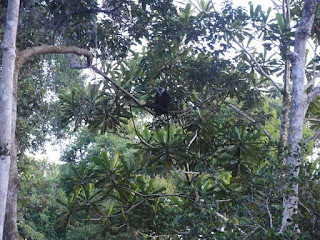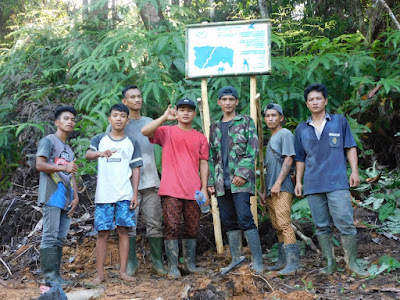Wednesday, June 30, 2021
Inisiasi pelestarian Hutan Tololago, Siberut
oleh : Damianus Tateburuk, Arif Setiawan
Hutan di sekitar
dusun Tololago Siberut Daya, Kabupaten Kepulauan Mentawai, menjadi bagian penting dari upaya pelestarian budaya dan alam pada umumya di Kep.Mentawai. Kegiatan yang di motori oleh tim Malinggai Uma, Mentawai Di Siberut
Selatan, telah menambah motivasi semangat untuk membangun inisiasi pelestarian alam dan
budaya dari tingkat bawah. Meskipun terkendala jarak dan situasi pandemic,
hasil diskusi secara daring dapat merumuskan kegiatan-kegiatan yang sepenuhnya
dilaksankan oleh Tim Malinggai Uma.

 |
| Penandatanganan kesepakatan bersama untuk melestarikan hutan Tololago dengan suku pemilik lahan disaksikan pemerintah Desa Tololago. |
 |
| Otus mentawi |
 |
| Pernis ptilorhynchus |
 |
| Simias concolor |
 |
| Presbytis potenziani siberu |
Survey juga dilakukan di beberapa jalur hutan Tololago dan menjumpai langsung primata endemik Mentawai , Simakobu ( Simias concolor) dimana IUCN telah mengkategorikan dalam status kritis ( Critically endangered), Bilou ( Hylobates klossii), Joja ( Presbytis potenziani siberu) burung pemangsa Sikemadu asia ( Pernis ptilorhynchus), burung hantu mentawai ( Otus mentawi). Jenis-jenis tersebut merupakan diantara sekian jenis-jenis asli Mentawai yang mempunyai potensi untuk mengundang orang ingin melihat lansung dan meluangkan biaya untuk rangkaian kegiatan pengamatan di hutan. Apabilah hal ini juga dapat dikelola dengan baik juga berpotensi untuk mendukung ekonomi untuk warga sekitar hutan dan mendukung kegiatan pelestarian jenis-jenis terancam punah dengan kegiatan wisata yang bertanggung jawab dan berkelanjutan. Oleh karena itu, kegiatan ini juga diharapkan dapat menjadi perhatian pemerintah daerah untuk mendorong upaya pelestarian hutan dan satwaliar termasuk memperkuat nilai budaya asli, dari sisi kebijakan daerah, yang juga menjaga keanekargaman tinggi diluar kawasan konservasi yang sudah ada.
Kegiatan di Tololago ini juga merupakan pembinaan generasi muda yang berada di wilayah kerja Mallinggai Uma, dengan melibatkan anak-anak muda untuk terlibat langsung dalam kegiatan pengenalan pengamatan satwaliar, dengan harapan dapat memotivasi kegiatan kegiatan pelestarian alam dan budaya selanjutnya.
Saturday, June 19, 2021
Primate Survey Method Training Program : Building capacity for young primatologist
written by Arif Setiawan, translated by TT Chan
The Primate Survey Methods Training Programme was held for the eighth time in May 2021, after having been delayed by the coronavirus pandemic. As in previous years, this was a collaboration with the Primate Study Group of Gadjah Mada University’s Faculty of Forestry. The Primate Survey Methods Training Programme, which we will refer to as PTP for short, aims to revitalise primate research, introduce basic primate survey techniques and create a network of primate conservation activists, all with a special focus on gibbon conservation.
The first PTP was held in 2013, with the initial goal of increasing the number of researchers and conservationists in Central Java. Between 2013 and 2019, 146 participants successfully completed the programme (see Table 1). Today, these PTP alumni are spread across different regions. Several of them are currently pursuing careers in primate and gibbon-related fields. They have started primate conservation projects encompassing tracts of gibbon habitat which had previously not been protected.
The training given in the PTP focusses primarily on a method of estimating the population density of Javan gibbons using triangulation sistem, line transects and vocal counts. The programme usually lasts three days, with one day for classes and two for field practice. All editions of the PTP so far have taken place in Sokokembang hamlet (Kayupuring Village, Petungkriyono District).
Training sessions are complemented by presentations by guest speakers, who share their experience doing research or primate conservation. Among the speakers invited during previous rounds of the PTP is Dr Bosco Chan (Kadoorie Farm and Botanic Garden, Hong Kong), who has done fieldwork on the Hainan gibbon – the rarest in the world – and visited in 2018. We also invited researcher Dwi Yandhi Febrianti, who works on the Celebes crested macaque (Macaca nigra) in North Sulawesi. In 2017 we have invited Dr. Andie Ang, raffle’s banded langur working group and Indonesian javan gibbon researcher, Rahayu Oktaviani as guest lecturer. We hope that the experiences of our invited researchers will inspire participants to embark on careers involving researching or conserving primates in Indonesia.
The PTP this year has had to be modified a little due to the pandemic. In addition to reducing the number of participants, we added a webinar before the main event at Sokokembang. This webinar, held on 22 May 2021, gave our guest speakers the opportunity to remotely address our 60 participants on various issues, which would normally have been presented live. Our first speaker, Dr Joe Smith, works as director of the animal programme at Fort Wayne Children’s Zoo. He talked about some activities at the zoo that contributed to ex-situ conservation initiatives and the role of Fort Wayne Children’s Zoo in gibbon conservation in particular. Our second guest speaker was Nur Aoliya, a primate researcher from Bogor Agricultural University (IPB) who is researching the bioacoustics of Javan gibbons in the Dieng Mountains. For those of you who did not have time to attend this webinar, you can watch the recording on YouTube.
After the webinar, the PTP commenced in the Sokokembang forest, with 15 participants who had previously been selected based on a letter of motivation and their involvement in past and future projects relating to gibbons or other primates. In addition to those selected, there were three invited participants at this year’s PTP from Siberut. They represent a project on the Dwarf siamang, endemic to the Mentawai Islands in West Sumatra.
This year’s PTP focused on training participants in the vocal count triangulation method, which we had two days to try out in the Sokokembang Forest. This is a method commonly used to survey gibbon populations. Nur Aoliya, the gibbon researcher from IPB we mentioned above, was in charge of introducing participants to the vocal count method. She had previously also received SwaraOwa’s Kopi Owa scholarship.
On our first day in the field, we selected sites called listening point from where we intended to listen out for gibbon calls the next day. We also did primate watching tours on the forest road that have been used regular monitoring. Its easy to spot all primates species that have been habituated to humans. In choosing our sites, we took into account how well we could hear forest sounds at each place and the topography of the Sokokembang Forest. In total, we settled on three listening points spaced around 500 m apart. On the same day, we also gave participants a feel of the primate diversity in Sokokembang, teaching them how to identify the different species and quickly estimate the number of individuals in each group they come across.
On the second day, we did a vocal count using the three listening points we had chosen the day before. Based on the loudness and direction of the calls, we estimated the positions of the gibbons. Each of the three sites was manned by one team of participants from 6.30 to 11.00am. All gibbon calls were recorded on specially prepared observation sheets. The data from each observation point was later analyzed to estimate gibbon abundance in the area covered. The advantage of using three listening points (triangulation) was that we could more accurately determine where each gibbon was calling from.
Over the three days of the programme, our participants managed to record the highest number of direct encounters (during priamate watching trip) with primates in the Sokokembang Forest so far compared to previous years: 30 individuals belonging to four species (Javan gibbon, Javan surili, Javan lutung and Long-tailed macaque). Towards the end of the programme, each team also presented the observational data they collected from the vocal count and an analysis of gibbon density.
We hope that the PTP 2021 has given all participants a good assortment of experiences in the field and a basic understanding of the methods used in gibbon surveys, as well as reached out to those in the younger generation interested in primate research, especially that relating to gibbons.
The Primate Survey Methods Training Programme 2021 was made possible by support from Mandai Nature, Wildlife Reserves Singapore, Fort Wayne Children’s Zoo and Ostrava Zoo. Our thanks are also due to Perhutani Pekalongan Timur and the Kayupuring Village Government, Petungkriyono District, Pekalongan Regency.





